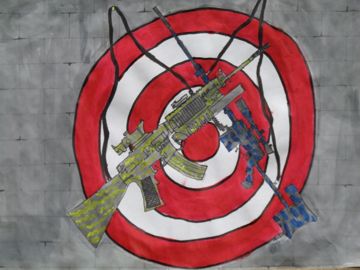Teaching with Contemporary Art
Working with Violent Images
Only a few days ago I was all set to write a post that highlighted the plight of Curtis Acosta, an Arizona teacher who finds himself in the position of teaching a class on Latino literature that has recently been “outlawed” in the state. But in light of the recent shootings in Arizona, while in no way diminishing the importance of the struggle Mr. Acosta and his students face, I decided to put that post on the back burner for a week or so in order to write this week about teaching with, or perhaps I should say negotiating violent imagery.
No one can argue that each day is swamped with a ton of pictures, especially for students. Some go by in a second. Some linger on the computer and tv. These images perhaps shape who we are (or become), and certainly inform how we act (and react) to things.
Students make violent images that often shock viewers just like professional artists. But in a school setting violent or controversial images have to be shared carefully. The audience has to be educated in ways that galleries and museums (sometimes) don’t have to worry about.
In a recent unit of study, many students in my classes created works that led to depicting subjects like natural disasters, the power of weapons, and even abortion. Rather than dissuade them from really exploring these topics, I encouraged them to create high quality paintings and be clear when it came to sharing what the work was about. In the end, students wrote and printed wall labels that hung with their work, explaining the inspiration and thinking behind the art.
As educators we sometimes find ourselves making decisions about whether to encourage or discourage exploration of difficult subjects that may lead to violent or controversial imagery. While most of us go with our gut and make these decisions based on district policy or past practice, it’s important to be on the encouragement side of this fence as often as possible, specifically because it allows students to express what their art work means and allows teachers, classmates, parents and the whole school community to use that conversation or written reflection to gauge how to best respond to the work, appreciate it, and even take specific action if necessary. On the other hand, if we routinely rely on saying, “You really can’t paint that in school."


No comments:
Post a Comment